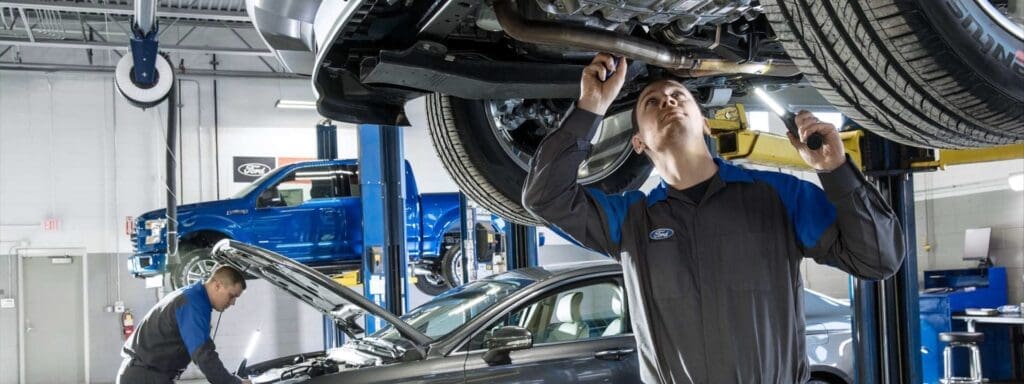So, you’ve just purchased your dream Ford performance vehicle and you couldn’t be more excited. From the power under the hood to the sleek design, you’re ready to hit the road and show off your new ride. But before you do, it’s important to familiarize yourself with some essential vehicle maintenance tips specifically tailored to Ford performance vehicles. In this beginner’s guide, we’ll walk you through everything you need to know to keep your Ford performance vehicle running smoothly, ensuring it stays in tip-top shape for years to come. From routine maintenance tasks to performance enhancements, get ready to become a pro at taking care of your beloved vehicle.

1. Introduction to Ford Performance Vehicles
1.1 What are Ford Performance Vehicles?
Ford Performance Vehicles, often referred to as FPVs, are a range of high-performance vehicles manufactured by Ford. These vehicles are specially designed to provide an exhilarating driving experience, combining power, precision, and advanced technologies. From sports cars to SUVs, Ford Performance Vehicles offer a wide range of options for performance enthusiasts.
1.2 Benefits of Owning a Ford Performance Vehicle
Owning a Ford Performance Vehicle comes with several exciting benefits. Firstly, these vehicles are engineered to deliver exceptional performance, with powerful engines and advanced handling systems. The exhilarating acceleration and precise control offered by these vehicles make every drive an unforgettable experience.
Another advantage of owning a Ford Performance Vehicle is the access to cutting-edge technologies. These cars are equipped with the latest features in terms of connectivity, entertainment, and safety. From advanced infotainment systems to driver-assistance technologies, these vehicles provide a seamless and safe driving experience.
Moreover, Ford Performance Vehicles have a strong reputation for reliability and durability. These vehicles undergo rigorous testing and engineering processes to ensure that they can withstand the demands of high-performance driving. With proper maintenance and care, you can expect your Ford Performance Vehicle to provide years of thrilling driving pleasure.
2. Understanding the Basics of Vehicle Maintenance
2.1 Importance of Regular Maintenance
Regular maintenance is crucial for keeping your Ford Performance Vehicle in optimal condition. By following a maintenance routine, you can extend the lifespan of your vehicle, prevent potential issues, and ensure that it continues to perform at its best. Maintenance helps to identify and address minor problems before they escalate into costly and major repairs.
Additionally, routine maintenance helps to maintain the vehicle’s value. When it’s time to sell or trade-in your Ford Performance Vehicle, well-documented and regular maintenance can significantly increase its resale value. Buyers are more likely to be interested in a vehicle that has been well-maintained.
2.2 Components of Vehicle Maintenance
Vehicle maintenance involves various components that need attention at different intervals. These components include checking and replacing fluids, inspecting filters, monitoring the battery and electrical system, inspecting belts and hoses, and much more. Each of these areas plays a crucial role in ensuring the overall health and performance of your Ford Performance Vehicle.
2.3 Maintenance Schedule for Ford Performance Vehicles
To ensure that your Ford Performance Vehicle receives the necessary maintenance, it’s essential to follow a maintenance schedule. Ford provides a comprehensive maintenance schedule in the owner’s manual, tailored specifically to each model and its recommended service intervals. By adhering to this schedule, you can stay on top of maintenance tasks and keep your vehicle running smoothly.
3. Essential Tools and Equipment for Maintenance
3.1 Basic Hand Tools
Having a set of basic hand tools is essential for performing routine maintenance on your Ford Performance Vehicle. These tools include wrenches, screwdrivers, pliers, sockets, and more. They allow you to tackle tasks such as fluid checks, filter replacements, and simple repairs.
3.2 Specialized Tools for Ford Performance Vehicles
In addition to basic hand tools, there are also specialized tools designed specifically for Ford Performance Vehicles. These tools may be required for tasks such as engine tuning, suspension adjustments, and performance upgrades. It’s important to invest in these specialized tools to ensure you can accurately and safely perform maintenance and modifications on your vehicle.
3.3 Safety Equipment
Safety should always be a priority when working on your Ford Performance Vehicle. Safety equipment such as gloves, safety glasses, and a fire extinguisher are essential to protect yourself and prevent accidents. Additionally, having a stable jack and jack stands for lifting the vehicle safely is crucial.
4. Performing Routine Maintenance
4.1 Checking and Topping Up Fluids
Regularly checking and topping up fluids is an essential part of vehicle maintenance. This includes engine oil, coolant, brake fluid, power steering fluid, and windshield washer fluid. By maintaining the appropriate fluid levels, you can ensure that the various systems in your Ford Performance Vehicle operate smoothly and efficiently.
4.2 Changing the Engine Oil
Oil changes are a fundamental maintenance task for any vehicle, including Ford Performance Vehicles. Regularly changing the engine oil helps to remove contaminants and ensure optimal lubrication, prolonging the life of the engine. It is crucial to follow the recommended oil change intervals and use the recommended oil type specified by Ford.
4.3 Inspection and Replacement of Filters
Filters, such as the air filter and cabin filter, play a vital role in maintaining the performance and cleanliness of your Ford Performance Vehicle. Regular inspections and replacements of these filters are necessary to remove contaminants from the air entering the engine and cabin, ensuring proper airflow and protecting the internal components.
4.4 Checking the Battery and Electrical System
The battery and electrical system of your Ford Performance Vehicle are crucial for powering various components and systems. Regularly checking the battery’s condition, cleaning the terminals, and inspecting the electrical connections will help prevent starting issues and ensure the proper functioning of electrical features.
4.5 Checking and Replacing Spark Plugs
Spark plugs are essential for the combustion process in the engine. Over time, they can become worn or fouled, leading to reduced performance and fuel efficiency. Regularly checking and replacing spark plugs according to the manufacturer’s recommendations will help maintain optimum engine performance.
4.6 Inspecting Belts and Hoses
Belts and hoses are crucial components in your Ford Performance Vehicle’s engine system. Regularly inspecting them for wear, cracks, or leaks is important to prevent potential failures that could lead to costly damage. If any belts or hoses show signs of wear or damage, they should be replaced promptly.
5. Tire Care and Maintenance
5.1 Importance of Proper Tire Care
Proper tire care is essential for both safety and performance. Adequate tire maintenance ensures optimal traction, handling, and braking, enhancing the overall driving experience. Regular tire care also extends tire life, saving you money on premature replacements.
5.2 Checking Tire Pressure
Maintaining the correct tire pressure is crucial for safety and fuel efficiency. Regularly checking tire pressure and inflating or deflating them to the recommended levels mentioned in the owner’s manual or on the tire placard will ensure even tire wear and optimal performance.
5.3 Rotating Tires
Tire rotation involves moving the tires to different positions on the vehicle, promoting even wear. This ensures that all tires wear out at a similar rate, maximizing their lifespan. Consult the owner’s manual or a professional technician to determine the recommended tire rotation pattern for your Ford Performance Vehicle.
5.4 Aligning and Balancing Tires
Proper wheel alignment and balancing are essential for maintaining stability, handling, and tire wear. Regularly checking and adjusting alignment and balancing, especially after hitting a curb or pothole, will help optimize the performance and longevity of your tires.
5.5 Tire Replacement
When the tread on your tires reaches the minimum legal depth or shows signs of wear, it’s time for replacement. Worn-out tires compromise safety and performance, so investing in high-quality replacement tires is crucial. Consult a professional technician or refer to your owner’s manual for the correct tire size and specifications.
6. Brakes and Suspension Maintenance
6.1 Brake Inspection and Pad Replacement
Maintaining a properly functioning braking system is vital for your safety and the performance of your Ford Performance Vehicle. Regularly inspecting the brake pads, rotors, and calipers for wear and replacing them when necessary ensures optimal braking performance and prevents potential brake system failures.
6.2 Brake Fluid Replacement
Brake fluid, like all other fluids, requires regular replacement to maintain its effectiveness. Over time, brake fluid can absorb moisture, compromising its performance and potentially causing brake system issues. Flushing and replacing the brake fluid at recommended intervals will help ensure proper braking performance.
6.3 Suspension Inspection and Maintenance
The suspension system of your Ford Performance Vehicle plays a crucial role in providing stability, comfort, and control. Regularly inspecting the suspension components for wear or damage and replacing worn-out parts will help maintain optimal performance and handling characteristics.
6.4 Wheel Alignment and Steering System
Proper wheel alignment and a well-maintained steering system are essential for a smooth and controlled driving experience. Regularly checking and adjusting wheel alignment and inspecting the steering components, such as tie rods and ball joints, will help ensure precise steering and improve tire wear.

7. Performance Upgrades and Modifications
7.1 Understanding Performance Upgrades
Performance upgrades allow you to enhance the already impressive capabilities of your Ford Performance Vehicle. Upgrades can include modifications to the engine, exhaust system, suspension, brakes, and more. It’s important to have a good understanding of how each upgrade affects the overall performance and characteristics of your vehicle.
7.2 Choosing the Right Upgrades for your Ford Performance Vehicle
When considering performance upgrades, it’s crucial to choose upgrades that align with your driving preferences and goals. Research and consult with experts or enthusiasts to determine which upgrades are suitable for your specific Ford Performance Vehicle model. It’s important to ensure that any modifications are compatible with your vehicle’s warranty.
7.3 Installation and Maintenance of Performance Parts
Proper installation and regular maintenance of performance parts are essential for maximizing their benefits and preserving the overall performance of your Ford Performance Vehicle. It’s recommended to have professional technicians install and maintain performance parts to ensure they are properly integrated and do not cause any adverse effects on the vehicle’s performance.
8. Maintaining the Interior and Exterior
8.1 Cleaning and Detailing the Interior
Keeping the interior of your Ford Performance Vehicle clean and well-maintained enhances the overall driving experience. Regularly vacuuming, dusting, and wiping down surfaces, such as the dashboard, seats, and steering wheel, helps prevent the accumulation of dirt and debris and keeps the interior looking fresh and inviting.
8.2 Protecting Seats and Upholstery
The seats and upholstery in your Ford Performance Vehicle can be subjected to wear and tear over time. Applying fabric or leather protectants can help repel stains and spills, extending the life of the seats and upholstery. It’s also important to address any stains or spills promptly to prevent permanent damage.
8.3 Cleaning and Protecting Exterior Surfaces
Maintaining a clean exterior not only improves the appearance of your Ford Performance Vehicle but also protects the paint and finishes from environmental elements. Regularly washing and drying the exterior surfaces, including the body, windows, and wheels, helps remove dirt, road grime, and contaminants that can lead to paint damage.
8.4 Waxing and Polishing the Paint
Waxing and polishing the paint of your Ford Performance Vehicle adds a protective layer and helps maintain its shine. Waxing provides a barrier against environmental elements, while polishing removes light scratches and swirl marks, restoring the paint’s luster. Regular application of wax and polish will help preserve the aesthetic appeal of your vehicle.
8.5 Maintaining the Windows and Windshield
Clear and unobstructed visibility is crucial for safe driving. Regularly cleaning the windows and windshield, both on the interior and exterior, with a suitable glass cleaner helps remove dirt, streaks, and grime. It’s also important to inspect the windshield wipers regularly and replace them when they become worn or ineffective.

9. Troubleshooting Common Issues
9.1 Identifying and Diagnosing Common Problems
Despite proper maintenance, issues may arise with your Ford Performance Vehicle. Learning to identify and diagnose common problems, such as engine misfires, unusual noises, and warning lights, can help you take appropriate action. Consult the owner’s manual or consider seeking professional help if you are unsure about the cause of the issue.
9.2 DIY Troubleshooting Steps
For minor issues, there are often simple troubleshooting steps you can take yourself. These may include checking for loose connections, inspecting fuses, or identifying and addressing common causes of specific problems. However, it’s important to exercise caution and not attempt repairs or diagnostics that are beyond your abilities or knowledge.
9.3 When to Seek Professional Help
It’s essential to recognize when a professional technician’s expertise is required. If you encounter complex problems, lack the necessary tools or knowledge, or if the issue involves safety-related components such as brakes or airbags, it’s best to seek the assistance of a qualified professional. Professional technicians are equipped with the expertise and specialized diagnostic tools to accurately identify and resolve issues.
10. Safety Tips and Precautions
10.1 Importance of Safety during Maintenance
Safety should always be a top priority during any maintenance tasks on your Ford Performance Vehicle. Working on a vehicle involves potential hazards such as sharp edges, hot components, electrical systems, and more. Taking appropriate safety precautions ensures personal safety and prevents accidents or injuries.
10.2 Proper Handling of Tools and Equipment
Using tools and equipment correctly is crucial for safety and effective maintenance. Follow the manufacturer’s instructions and recommended procedures for using each tool to prevent damage and injury. Ensure that tools are in good condition, free from defects or damage, and use appropriate protective gear when necessary.
10.3 Safe Lifting and Jacking Techniques
Proper lifting and jacking techniques are important to prevent injuries or damage to your Ford Performance Vehicle. Always refer to the owner’s manual for the recommended lifting points and procedures. Use sturdy and properly rated jacks and jack stands to support the vehicle securely and prevent accidents while working underneath.
10.4 Dealing with Hazardous Materials
During maintenance, you may come into contact with hazardous materials such as engine fluids, chemicals, or battery acid. It’s important to handle these materials with caution and use appropriate protective measures. Wear gloves, safety glasses, and other necessary safety gear to minimize exposure and prevent potential harm.
10.5 Fire Safety Guidelines
Working on a vehicle involves the potential risk of fire due to flammable materials, electrical systems, or sparks. It’s crucial to have a fire extinguisher readily available in case of emergency. Additionally, avoiding smoking or open flames in the vicinity of the vehicle and ensuring proper ventilation when working with flammable materials are essential fire safety precautions.
By following the comprehensive maintenance guide outlined in this article, you can ensure that your Ford Performance Vehicle remains in optimal condition, providing you with the thrilling driving experience it was designed for. Regular maintenance, proper care, and attention to detail will help you enjoy the performance, reliability, and longevity of your beloved Ford Performance Vehicle for years to come.



